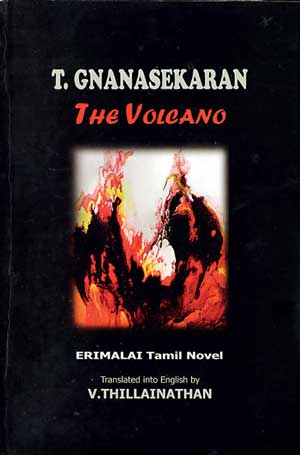Tuesday Apr 01, 2025
Tuesday Apr 01, 2025
Saturday, 10 December 2022 00:00 - - {{hitsCtrl.values.hits}}
 Reading this book written and based on the events of 1984 in the early days of the militancy in Jaffna, 13 years after the end of the three-decade long armed conflict, makes one feel as if witnessing the narrations of a patient prior to a life debilitating illness. The metaphor of patient in this context could be used to describe our country, Sri Lanka.
Reading this book written and based on the events of 1984 in the early days of the militancy in Jaffna, 13 years after the end of the three-decade long armed conflict, makes one feel as if witnessing the narrations of a patient prior to a life debilitating illness. The metaphor of patient in this context could be used to describe our country, Sri Lanka.
The story begins with a medical doctor in Jaffna, Dr. Mahesan being forced to treat a wounded LTTE member who robs a bank as part of a gang and shot at by the Police.
Soon after, Dr. Mahen and his wife are visited by his brother Chandran’s Sinhala friends from the South Mr. and Mrs. Wimalasiri who are planning to offer a religious vow in Jaffna. Mr. Wimalasiri is a business consultant and his wife is a Professor of Sociology at Kelaniya university. They are accompanied by Mrs. Wimalasiri’s unmarried sister who is a stenographer. Dr. Mahesan’s brother Chandran is boarded at their house in Colombo. They converse in English, the link language for many Tamils and Sinhalese.
The book gives voice to the Sinhala sentiments as well as diverse Tamil views and can be called a truly objective work of literature where within the conversation of the characters in the plot, a full spectrum of opinion of the socio-political issue at hand is provided.
Here are a few excerpts from the book that is between the Wimalasiri family and their hosts in Jaffna, Dr. Mahesan and his vehemently anti-LTTE brother Chandran. Chandran is largely seen as a ‘Colombo dweller’ by some of his Northern friends.
“Is this your first visit to Jaffna, Mr. Wimalasiri?”
“No doctor, I happened to tour Jaffna with my classmates fifteen years back. Even my wife has been to Jaffna once as a small girl.”
“We have to make a vow at the Buddhist temple in Nagadeepa. We have now had the opportunity to fulfil our duty. My sister Anula has never visited Jaffna. She wanted to come with us and hence her presence,” said Mrs. Wimalasiri.
“As a matter of fact, Mrs. Wimalasiri is allergic to Jaffna. She is terrified because of news reports about Jaffna,” Chandran chuckled.”
“I have told these people several times not to judge people by unfavourable press reports. They will change their minds when they see for themselves what is happening here,” Chandran told his brother.”
The above discussion gives a basis for what unfolds in the story – where two realities unfold; the reality of the ordinary people and that of the artificially projected and exaggerated reality. This book helps to differentiate the two especially as it captures the romantic relationship between Anula, the sister of Mrs. Wimalasiri, and Chandran.
Below is another excerpt:
“The ethnic riots of 1977 were behind Dr. Mahesan’s decision to start a private hospital. The fight between the security guard and some policemen who tried to forcefully enter a carnival on St. Patrick’s ground without producing their tickets erupted into an ethnic riot all over Sri Lanka at a time when Dr. Mahesan and Mala were working for the government hospital in Anuradhapura.”
“The talk of the town and the hospital centred on the riots. Rumours spread like wildfire.”
On macro political decisions that impacted the people the below conversation between an educationist referred to as Master and Dr. Mahesan’s family gives some insight;
“Some Sinhala intellectuals were not in favour of the “Sinhala Only Bill.” They maintained that it was a dangerous move.”
“Do you mean to say that some Sinhalese opposed the Act? I can’t believe my ears,” Chandran was surprised.
“Are you referring to the speech made by Dr. Colvin R. de Silva who said in parliament “Do we want an independent Ceylon or two bleeding halves of Ceylon, which can be gobbled up by every ravaging imperialist monster that may range the Indian ocean?” These are the issues that in fact we have been discussing under the form and appearance of the language issue – One language – Two nations; Two languages, one nation,” said Mrs. Wimalasiri.
“Remarkably, Leslie Gunawardena and Dr. N.M. Perera too supported Colvin in opposing the ‘Sinhala only’ bill in parliament.”
Similar to the above discourse, there are a range of conversations that look at anti LTTE sentiments amongst Tamils of Jaffna and how some oppose these views opining that militancy was unavoidable.
What keeps the story on a lighter vein is the love affair blossoming between Chandran and Mrs. Wimalasiri’s sister Anula. The immunity of young people to ethnic polarisation is presented very convincingly.
Very few novelists could possibly get this kind of neutral approach, which while representing the Tamil voice, is also inclusive of the Sinhala majority views.
The story ends with the young couple ready to marry even if their respective Tamil and Sinhala families’ object.
The interpretation of this ending is indicative of a larger truth; that the people of this country can unite and decide on the prosperity they could mutually achieve irrespective of varied machinations.
The book is a must read for all Sri Lankans so that we look at the mistakes of the past and see to it that we do not commit them in the future.